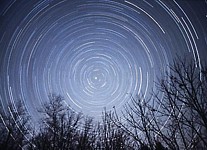Below you will find observational experiments that do not require optical instrumentation, to be practiced at night. Some require few observation and monitoring sessions to become aware, others merit continuous recording. The exercises are designed to simulate the total absence of astronomical knowledge, with the aim of demonstrating that it is possible to identify phenomena of this nature using only naked eye observation and reasoning.
Astronomy experiments without a telescope (at night):
1) The stars describe an apparent movement, but relative to a particular "fixed" point.
 If you do the exercise of contemplating the apparent movement of the stars, even for a few minutes, it is possible to see that they all move in the same direction (East-West), but by examining more closely, for a few hours, it is possible to notice that in some sectors the stars move much more slowly, and that they seem to be describing a curve, instead of a continuous line, and around a particular fixed point; in other words, in one area of the sky the stars seem to be "revolving around something«. By observing the apparent motion of stars for several nights in a row, it is possible to observe that this zone of "curved motion of the stars" is always the same, and that throughout the night, the stars always appear to be rotating around that point.
If you do the exercise of contemplating the apparent movement of the stars, even for a few minutes, it is possible to see that they all move in the same direction (East-West), but by examining more closely, for a few hours, it is possible to notice that in some sectors the stars move much more slowly, and that they seem to be describing a curve, instead of a continuous line, and around a particular fixed point; in other words, in one area of the sky the stars seem to be "revolving around something«. By observing the apparent motion of stars for several nights in a row, it is possible to observe that this zone of "curved motion of the stars" is always the same, and that throughout the night, the stars always appear to be rotating around that point.
Preliminary conclusion: Discovery of the Celestial Pole. The Earth, as we know, rotates around its axis in space, which gives rise to the existence of a North and South Pole, according to each hemisphere. Although an observer is unaware of this point, the terrestrial poles are projected into space in a name called the Celestial Pole, which can be North or South, which respectively are the points around which the stars appear to rotate during the night. This lays the foundation for understanding rotational dynamics, even when this rotation is associated with the starry background instead of the Earth's rotation.

